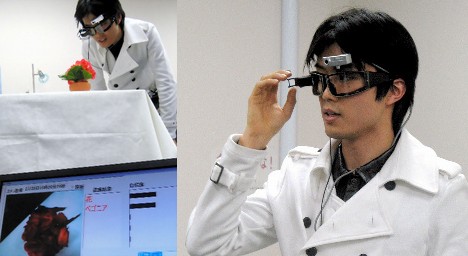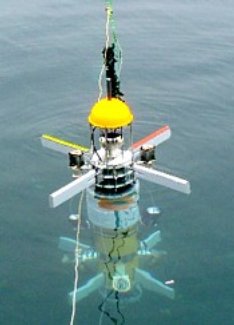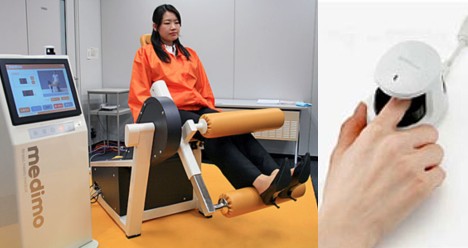 For those who believe laughter is the best medicine, now there is a way to measure the dosage. Researchers at Kansai University have developed a machine that can scientifically measure the quantity of a person's laughter, as well as distinguish between the real and the fake.
For those who believe laughter is the best medicine, now there is a way to measure the dosage. Researchers at Kansai University have developed a machine that can scientifically measure the quantity of a person's laughter, as well as distinguish between the real and the fake.
The laughter measurement system, which the researchers say will help scientists conduct more detailed research into the physiological effects of laughter on the immune system, relies on a series of electrode sensors that monitor the tiny amounts of bioelectricity generated by certain muscles that flex when you chuckle. The sensors, which attach to a person's cheeks, chest and abdomen, take 3,000 measurements per second. Sensor data is relayed to a computer, where it is analyzed by special software that determines the nature of the laugh and assigns a numerical score based on the quantity.
The laughter quantity is expressed in terms of "aH" -- a unit of measurement developed by the research team. According to chief researcher Yoji Kimura, a Kansai University professor, 1 second of explosive laughter amounts to 5 aH.
The system distinguishes between real and fake laughter by closely monitoring the movement of the diaphragm -- the thin sheet of muscle extending across the bottom of the rib cage, which separates the chest organs from those of the abdomen. According to Kimura, the diaphragm does not vibrate significantly when a person pretends to laugh, even when the person's voice and facial expression appear genuine. On the other hand, when one laughs at something they truly find funny, the diaphragm generates 2 to 5 distinct vibrational waves per second.
At Kansai University on February 21, the researchers publicly demonstrated the system by measuring the laughter of a 30-something-year-old woman and her 5-year-old daughter as they watched a performance by Yoshimoto comedians. The mother, who apparently found no humor in the comedy routine, experienced only slightly more than 0 aH of laughter, while her amused daughter experienced a hearty 42 aH.
The researchers, who spent over a year developing the system, are aiming to create a portable version of the system for use in health and entertainment devices.
[Sources: CNet Japan, Asahi]






 The company came up with the idea for Kirichimpo last year after witnessing the far-reaching success of Marimokkori, a happy, well-endowed green monster mascot from Hokkaido, whose name is a play on the words marimo (a type of giant algae ball found in Lake Akan) and mokkori ("erection"). Marimokkori's popularity extends far beyond Hokkaido's shores, to as far away as Chiba, the home of his younger peanut-headed cousin named Mamemokkori (mame means "bean"), and Tokyo, where mounds of the popular Marimokkori can be found inside UFO Catcher claw vending machines at game centers.
The company came up with the idea for Kirichimpo last year after witnessing the far-reaching success of Marimokkori, a happy, well-endowed green monster mascot from Hokkaido, whose name is a play on the words marimo (a type of giant algae ball found in Lake Akan) and mokkori ("erection"). Marimokkori's popularity extends far beyond Hokkaido's shores, to as far away as Chiba, the home of his younger peanut-headed cousin named Mamemokkori (mame means "bean"), and Tokyo, where mounds of the popular Marimokkori can be found inside UFO Catcher claw vending machines at game centers.
 For those who believe laughter is the best medicine, now there is a way to measure the dosage. Researchers at Kansai University have developed a machine that can scientifically measure the quantity of a person's laughter, as well as distinguish between the real and the fake.
For those who believe laughter is the best medicine, now there is a way to measure the dosage. Researchers at Kansai University have developed a machine that can scientifically measure the quantity of a person's laughter, as well as distinguish between the real and the fake.  As long as oil is transported by sea, accidental spills will remain a threat to the marine environment. When an oil spill occurs, the cleanup response must be quick in order to minimize the environmental and economic impact. To help speed up the response, researchers at Osaka University are developing an autonomous marine robot that can track down spilled oil and provide real-time location data.
As long as oil is transported by sea, accidental spills will remain a threat to the marine environment. When an oil spill occurs, the cleanup response must be quick in order to minimize the environmental and economic impact. To help speed up the response, researchers at Osaka University are developing an autonomous marine robot that can track down spilled oil and provide real-time location data.